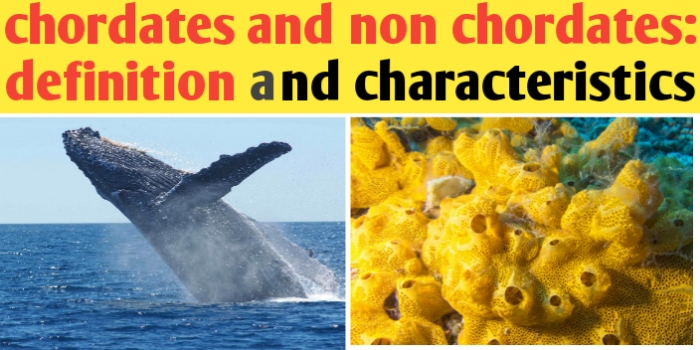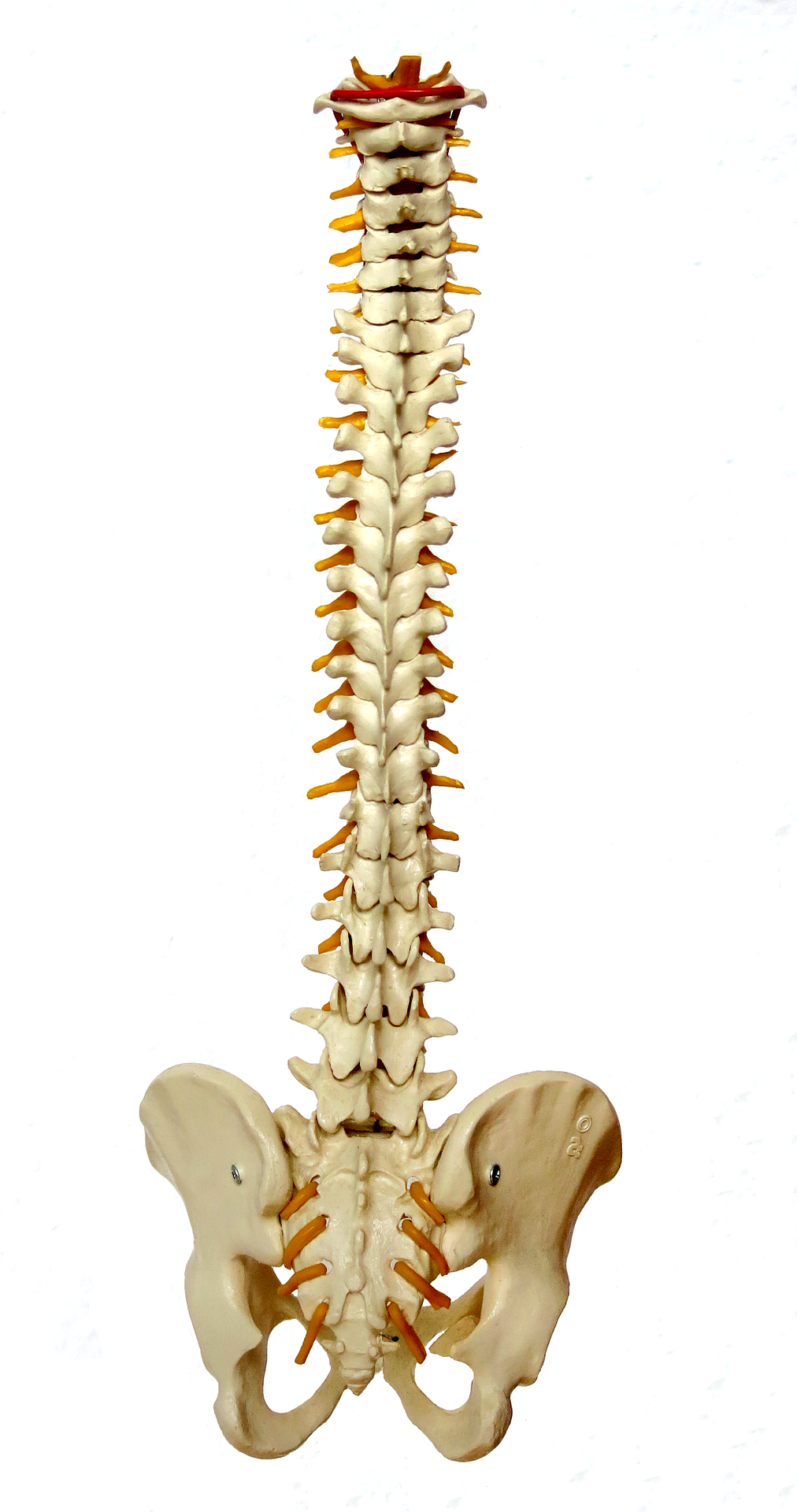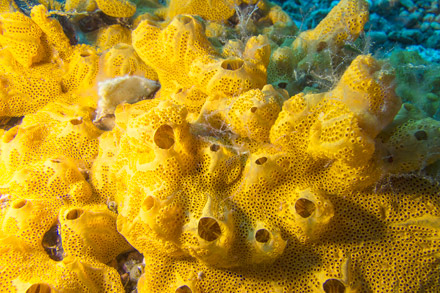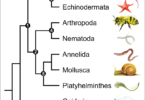Chordate and non chordate Difference | characteristics and facts, hi guys in this article we know about chordate and non chordate difference, their definition, examples and characteristics.
In a scheme of classification The Animal Kingdom is divided into several major animal groups called phylum, the major group of animal kingdom is known as chordata. animal has a notocord or backbone in their body structure are chordates. Contrary, Non-chordates are the animals without backbone or notochord, this the vital difference between chordates and non-chordates

Chordate and non Chordate Difference | characteristics and facts
These animals belong to the different phyla of the animal kingdom. Also being same at the multicellular level, there is a lot of difference between patterns of organization of cells in this kingdom. Lower animals like coelenterates, sponges differ in cellular level of organization, at the organ level (radial and bilateral) Platyhelminthes and other members differ.
◆ Follow me on YouTube
◆ VISIT ON OUR YOUTUBE CHANNEL BIOLOGY SIR FOR MORE VIDEO
While higher animals like arthropods, annelids, mollusks, comes under Non-chordate and Amphibia, pisces,Aves, Reptiles, mammals fall under chordates, they all differ in some of their special physiological function and other unique features like body symmetry, digestive, circulatory or reproductive system, etc.
The design of classifying, the animal kingdom is broadly divided into several major groups called phyla. Till yet there are approximately 30 animal phyla recognized. The last and the major group of the animal kingdom was the phylum Chordata.
Table of Contents
What is chordate ? Its definition characteristics and facts
What is chordate ? The last major group of the animal kingdom is known as Phylum for chordata, it was created by Balfour in 1880. The name of phylum is derived from tw Greek words, chorde meaning a string or cord, and ata meaning bearing.
The common characteristics feature in the form of a stiff, supporting rod like a structure along the back the notochord. Notochord is Greek word formed of two word noton means back and chorda means cord, so chordate is cord bearing animal in back.
Chordate definition is, the animal which have presence of notochord or backbone in their body structure is known as chordate.
The animal belonging to all other Phylum of animal kingdom are often termed as non chordates, “the invertebrates” since they have no notochord or backbone in their body structure.
Chordate Animals
The Phylum chordata comprise of amphibia, pisces, reptiles, aves and mammals. Phylum chordata is the largest of the deuterostome phyla, it is the highest and the most important Phylum comprising a vast variety of living and extinct animals including man himself.
Most of living animals chordate are also known as vertebrates animals such as fishes amphibians, reptiles, birds and mammals.
Chordate diversity
The chordates exhibit diversity of form physiology and habit, the number of chordate species is not large, about 49000 species are on record which are only half of living species of mollusca, chordate subphylum urochordata phylum cephalochordata claim nearly 2500 species and subphylum vertebrata include about 46500, number of species fishes are 25000, amphibian species is about 2500, and reptiles about 6,000 and birds about 9000 and mammals are about nearly 4500.
Despite their low number of species of chordate make a great contribution to the Biomass of Earth. Nearly all of them are medium to large in size. The gigantic blue whale which grows to 35 metres long and 120 ton in weight is the biggest known animal.

The gigantic blue whale
The chordates are not only the largest animals in the existence today but ecologically they are among the most successful in the animal kingdom. All lower chordates are marine, fishes are aquatic and higher chordates are predominantly terrestrial.
Chordate three fundamental characters
All the chordates possess three out standing unique characteristics at some stage in their life cycle,these features include:-
1) A dorsal hollow or tubular nerve cord
2) a longitudinal supporting rod like notochord
3) presence of series of pharyngeal Gill slits.
These three distinctive features which set chordates apart from all other phyla,
1) dorsal hollow nerve cord: the central nervous system of chordates is present dorsally in the body, it is in the form of longitudinal hollow or tubular nerve cord lying just above the notochord and extending lengthwise in the body.
2) rod like presence of notochord: the notochord is an elongated rod like flexible structure extending the length of the body, it is present immediately beneath the nerve cord and just above the digestive canal. It originates from the endodermal roof of the embryonic archenteron.
Presence of notochord is the Prime Diagnostic feature of the Phylum chordata which derived its name from it, it serves as a support for internal a skeleton and is not to be confused with nerve cord.
3) Pharyngeal Gill slits: in all the chordates at some stage of their life cycle a series of pair literal Gill clefts or Gill slits perforated through the pharyngeal wall of gut behind the mouth. They serves primarily for the purposes of passage of water from the pharynx to outside the bathing the gills for respiration.
In Protochordates in lower aquatic vertebrate the gill slits are functional throughout life, but in higher vertebrate they disappear or become modified in the adult with acquisition of Pulmonary respiration.
● Conclusion: the above three common features appear during early embryonic life of all the chordates animal but all three features rarely persist in the adult, often they are modified or even lost in the adult stage of higher chordates and notochord disappear during development in most vertebrate while nerve cord and the pharyngeal gill slits remain in the adult.
General characters of phylum chordate
1) chordate animals are aquatic, aerial Terrestrial and all free living with no fully parasite forms
2) body small to large, bilateral symmetrical and metamerically segmented
3) postanal tail is usually projects beyond the anus at some stage in may or may not persist in the adult.
4) body wall of chordates is triploblastic with three germ layers: ectoderm, mesoderm and endoderm.
5) Exoskeleton often present in chordate well developed in most vertebrate
6) Coelomate animals having a true Coelom, and enterocoelic or schizocoelic in origin.
7) a skeletal rod, the notochord present at some stage in life cycle
8) endoskeleton consists of cartilaginous or Bony, living and jointed present in the majority of members of vertebrates
9) Pharyngeal Gill slits present at some stage may or may not be functional
10) digestive system complete with digestive glands
11) blood vascular system closed type and heart ventral with dorsal and ventral blood vessels, Hepatic portal system well developed.
12) excretory system comprising proto or meso or meta nephric kidneys

Backbone in chordate animals
Origin and history of chordate
There is great deal is known about modern chordates including the lower forms their origin remain of obscure. Most zoologist now favour the deuterostome line of chordate evolution, according to which Phylum echinodermata, Hemichordata and chordate show common ancestry on embryological and biochemical evidence.
What is non chordate? Definition characteristics and facts
What is non chordate? The animal which have absence of notochord in their body is known as non chordate. Non chordate animals belongs to porifera, Coelenterates, Platyhelminthes, Aschelminthes, Annelida, Arthropoda, Mollusca,echinodermata and hemichordata.
According to their mode of living non chordate may be solitary like tapeworm, gregarious live in group for example locust, colonial live in social core example is honey bees, wasps and termite.
The lower non chordate animal sponge is sedentary maintain a water current to draw food to them, some are parasitic in nature like taenia solium number of round like Ascaris live in intestine of man.

A sponge is the sedentary animal
Chordate and non chordate animal have several differences between and now we have to discuss comparison of characteristics features of chordate and non chordate animals.
Comparison (Differences) between Chordate and non Chordata
It is fact that we have seen animal kingdom is traditionally divided into two unequal groups chordate and non chordate. All the chordates animal belong to a single phylum known as Chordata.
Chordates which are characterized by the presence of dorsal hollow nerve cord, a series of pharyngeal Gill slits and unique supporting axial rod or notochord or vertebral column running through the length of the body. The non chordates or invertebrates belongs to the lower animals which do not possess a notochord or vertebral column.
Now discuss chordates and non chordates characteristics comparison and their differences
● 1) Symmetry : the chordate animal have bilateral symmetry in which body can be divided in similar parts by only one plane along the longitudinal axis of the body, the animal having bilateral symmetry are collectively placed in group Bilateria.
But non chordate have radial, biradial symmetry, some are asymmetrical also. Asymmetrical animals are those in which their body cannot be divided into two similar parts from any direction for example a sponge, in radial symmetry body can be divided into two similar parts by any plane along oral-aboral axis of body eg. sponge, Coelenterates,echinoderms who are collectively present in the group Radiata.
● 2) Metamerism:- Chordate have internal metamerism by repetition of ribs,vertebrae,nerves muscles etc,
But in annelids arthropods mollusca there is a repetition of internal body part known as metamerism. in annelids earthworm body is externally divided into segments called metamers or somites by grooves called annuli and body cavity is internally divided by Septa.
In tapeworm new segment called proglottids are formed from the neck by the process of strobilation this kind of segmentation is known as pseudometamerism.
● 3) Post anal tail:- chordate have presence of post anal tail but it is lacking in non chordates
● 4) grade of organisation: chordate have organ system grade of organisation but non chordates have protoplasmic grade of organisation.
In cellular organisation the animal body is formed of many cells but the cells shows no coordinates to form tissues, for example in a sponge. And in tissue organisation the animal body is formed of many cells which coordinates for specific function and form four types of tissues, epithelial tissues, connective tissues, muscular tissues & nervous tissues, it is present in Coelenterates like hydra.
In organ system organisation the body is multicellular and cells coordinate to form tissues and organs and system, for example organ system organisation it is found in flatworms to mammals.
● 5) Germ layers:- chordates animals are generally triploblastic but non chordate animals are diploblastic.
On the basis of number of germ layers the animals are divided into two category diploblastic animals and triploblastic animals.
In diploblastic animals like a sponge and Hydra gastrula is with two germs layer, outer germ layers is it ectoderm and inner germ layer is endoderm so they are called diploblastic animal.
In triploblastic animal from flatworm to mammals gastrula larva is with three germ layer, outer ecotoderm,middle mesoderm and inner endoderm, so these are called triploblastic animals.
● 6) Coelom: chordates animals are true coelomate but non chordate animals are Acoelomate, pseudocoelomate.
Coelom or body cavity is the space between body wall and gut wall, so the coelom separates the muscles of gut and body wall.
Among invertebrate upto flatworm non chordate animals there is no Coelom and they are called Acoelomate animals. In Aschelminthes roundworms example Ascaris Coelom is present but not lined by peritoneal layer so it is called pseudocoelom or false coelom so Roundworm are pseudocoelomates animals.
From annelida to mammals body cavity is lined by peritoneal layers these are parietal peritoneum on outer side and visceral peritoneum on inner side it is called True coelom,so these are called True coelomate animals. It is filled with coelomic fluid.
In arthropods and mollusca true coelom is reduced and body cavity is a pseudocoel with blood and is called haemocoel and animals are called haemocoelomate.
On the basis of origin coelom is of two types Schizocoel and Enterocoel. When coelom is formed by splitting of mesoserm for example annelida, arthropod and mollusca. the animals having schizocoelic coelom are grouped in Schizocoela. Enterocoel is coelom is formed from the enteron of gastrula for example echinoderm and chordates such animals are grouped in Enterocoela.
● 7) Notochord: notochord present in chordate animal in some stage or replaced by a backbone made of ring life vertebrae but notochord for backbone lacking in non chordate animal.
● 8) Gut position: ventral to nerve cord in chordate animal and dorsal to nerve cord in animal
● 9) pharyngeal gill slits:- present at some stage of life in chordate animal but it is absent in non chordate animal
● 10) Body temperature: in chordate mammals & aves are warm blooded and amphibia, pisces and reptiles are cold blooded animal but all non chordate are cold blooded animal.
Birds are warm-blooded animals that have a much higher metabolism, and thus higher body temperature, than humans. While the exact measurement varies for different bird species, the average bird’s body temperature is 105 degrees Fahrenheit (40 degrees Celsius.
● 11) regeneration power: regeneration power in chordate animal is higher than chordate animal.
● 12) circulatory system:- in chordate animal circulatory system is closed type and blood flows at faster speed and higher pressure due to force provided by the contraction of Heart and blood is red due to hemoglobin in RBC.
In closed circulatory system blood remains inside the blood vessels, it is found in most of annelids and all vertebrates, in this blood flows at faster speed and high pressure due to force provided by contraction of heart and exchange of materials occurs through tissues fluid, it can be regulated according to need of the body.
In open circulatory system the blood comes out of blood vessels in space called sinuses. It is found in arthropods, most of mollusca and leech. In this blood flow at Slow speed and low pressure there is direct exchange of material between blood and the body.
Arthropods and mollusca have body cavity which is filled with blood and is called haemocoel, colour of blood depend upon pigment present in blood for example in annelid blood is red due to an iron containing haemoglobin present in plasma.
● 13) digestive system:- digestive system in chordate animal is complete, it means alimentary canal has mouth for ingestion and anus for egestion it is found in Round worm to mammals.
When alimentary canal has only mouth for both ingestion and egestion is incomplete digestive system, it is found in coelenterates Hydra and Flatworm.
● 14) excretory system: on the basis of nature of main nitrogenous waste material excretion is of three types 1) Ammonotelism 2) Ureotelism 3) Uricotelism.
Ammonotelism: when main nitrogenous waste material is ammonia NH3 and animal processing ammonotelism are known as ammonotelic animal. It is found in aquatic animals like protozoans, sponge, coelenterates, crustaceans echinoderms and Bony fishes.
Ureotelism: the main nitrogenous waste material is urea and the animal processing it is called ureotelic animal. the loss of water along with urea is comparatively less, it is found in amphibians, mammals and cartilaginous fish.
Uricotelic:- the main nitrogenous waste material is uric acid and animal processing it are called uricotelic animal. Water loss is quite less it is expelled as Semi solid paste. It is found in reptiles, birds and insects.
Mollusca animals like Limnaea, Unio are aminotelic non chordate animal which expel amino acid. Mobile circuit and Bony fishes like teleosts have trimethylamine as nitrogenous waste material.
● 15) respiratory system: it deals with exchange of environmental Oxygen and body carbon dioxide to oxidize glucose to produce energy rich ATP molecule.
In a sponge and coelenterates Every cell of body is in direct contact with surrounding water and exchange of gases occurs through their body surface. But higher animals have thick body wall and so they have special respiratory organs and mode of respiration.
Branchial respiration is found in crustaceans, cartilage and Bony fishes, it respire through the gills.
Cutaneous respiration is found in annelids and amphibia, it respire through the skin.
Tracheal respiration is found in insect Centipede and millipede, it respire through the respiratory organ tracheal system or tracheae.
Pulmonary respiration is found in most of tetrapods, it respire through the respiratory organ lungs.
In a spider and a Scorpion there is mode of respiration known as Book lung respiration and their respiratory organ is Book lungs.
Characters common to Chordates and higher non Chordates
There are a number of features in which the chordates animal resembling the higher non chordate
● 1) Axiation: the body in both has distinct polar Axis, it means it has anterior end is differentiated into cephalic region or head that is usually preceds in locomotion.
The opposite or posterior ends forms that tail in most cases. This longitudinal axis of the body running from head to tail is known as anterior-posterior axis.
However this axis body organisation is not strictly homologous into to animals group chordates and non chordates. The head into group is not homelogous because the blastoporal end developed the mouth in most non chordate animals but forms the anus in chordates animal.
● 2) Bilateral symmetry: due to existence of longitudinal anterior posterior axis the body of all chordate and most Higher chordates like annelida and arthropod exhibit bilateral symmetry.
● 3) Triploblastic conditions:- invertebrate flatworms to echinoderm and all chordates are triploblastic in nature. They have three germ layers ectoderm, endoderm and mesoderm.
● 4) Coelom:- a secondary body cavity or true coelom exist between the body wall and the digestive tube and it is lined on all sides by mesoderm. However it is differ in its mode of origin and different group of chordates and non chordates animal
● 5) Metamerism: metamerism is a condition in which the body is composed of linear of series similar body segments called metameres or somites.
● 6) Organ system: in organ system several organ work together for same function, such as digestion, circulation, respiration etc. Organ system plan for grade of organisation is shown by all the Chordates and for non chordates animals.
Advancement of Chordates over other Phyla
Phylum chordata has some advantages over other phyla Due to certain characters.
● 1) Living endoskeleton: with the exception of echinoderms and few others only chordates posses a living endoskeleton. It grows in size with the rest of the body so that there is no compulsion to shed it periodically to allow for growth like nonliving chitinous of endoskeleton of non chordate animals.
This living endoskeleton permits greater freedom of movement and indefinite growth so that many chordates are largest creature of the animal world.
● 2) Efficient respiration: the gills in aquatic chordates and the lungs in Terrestrial forms from efficient organ of respiration. The tracheal system of certain arthropod is also efficient but it is suitable to animal of a small size only.
● 3) Efficient circulation:- the circulatory system of the Chordates is well developed and the blood flows freely in the respiratory organs ensuring Rapid exchange of gases.
● 4) centralized nervous system: the invertebrates Phylum show or growing tendency of centralisation of nervous system, reaching its culmination in higher chordates.
◆ Conclusion:
Complexities at cellular, physiological and functional level, is the noticeable difference among all kinds of animals. These features empower us to classify them broadly. From the Porifera which is at lowest level among the kingdom Animalia to the highest level of Chordata, development was been noticed at every stage, this may be due to the adaptations or changes in the environmental condition in which they use to live.
So, from the above article, we conclude that there is diversity in every form of life, and they all are characterized by some or the other distinct character whether they are lower animals like Porifera, Coelenterata, Annelida or higher like Mammals, Aves, Reptiles, etc.






Leave a Comment